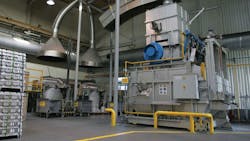Cutting Melting Energy Cost for Aluminum
Lenaal Andrzej Pokusa is an aluminum and zinc diecaster at Radom, in central Poland, and like automotive suppliers everywhere it seeks technology and process advantages to enhance its market position. Lately, it is saving costs and improving its processes with a new tilting melting and holding furnace operation.
In addition to automotive customers, Lenaal supplies castings for engineering, electronics, household equipment, construction, and military applications.
The StrikoMelter MH II system was developed in Germany by StrikoWestofen, and assembled at its factory in Strzelce Opolskie, Poland. The furnace replaces two crucible melters that, at 120 m3 of gas per metric ton of molten aluminum, consumed nearly twice as much gas as the StrikoMelter. Thanks to its low gas consumption, the managers at Lenaal expect the investment to be repaid after about two years of operation.
Further savings result from the considerably improved material efficiency (up to 99.7%) and considerably shorter downtime resulting from longer intervals between maintenance.
In daily operation, the system does not only produce melt of excellent quality – it is also extremely economical:
The Most Important Measurement
For the owner-managed foundry, high-quality castings are the most important measure of improvement. Because several of the automotive castings it producers are described as “safety relevant,” a homogenous and oxide-free melt with a low-density index is vital to the quality of its products. The rising prevalence of global quality standards underscored the need for a new melting process, and the order was placed with StrikoWestofen in 2012.
“We have had more than 20 years of experience in diecasting, and we supply customers in Europe and the United States,” explained Lukas Pokusa, production manager of Lenaal. “Economy is a vital factor in international competition, besides high casting quality. Thanks to the StrikoMelter technology, we now have a decisive competitive advantage.”
Comparedwith the crucible melting furnaces used up to now, the efficiency of StrikoMelter melting furnaces reduces the energy consumption per metric ton of molten aluminum by nearly half.
The reason for this is the use of targeted melting exhaust-heat recovery to preheat the furnace charge material. StrikoMelter melting furnaces have a shaft geometry that combines the melting phases of preheating, heating and melting in one single shaft. This integrated heat-recovery process reduces the melting energy requirements, thereby achieving considerable savings in fuel consumption. Also, the speed of the melting process reduces metal loss due to oxidization; as a result, material yields of up to 99.7% are achievable.
“Our StrikoMelter furnaces are based on knowledge accumulated through decades of experience, but it was possible to improve those even more using modern development tools such as computational fluid dynamicsand the finite element method,” explained StrikoWestofen CEO and development Rudolf Riedel. “Our excellent results can only be achieved thanks to process-optimized design and the exact realization of refractory lining and furnace chamber geometry.”
